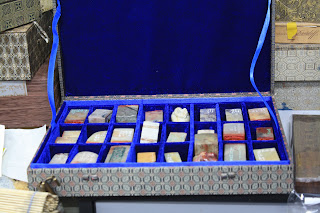His collection of different sizes of Chinese brushes. Amazing.
Part of the mini library section at his art studio.
Continue his painting on the wall. Quite a big piece of rice paper.

Some of the tools and materials he used during the process.
Getting the right amount of ink in the brush by spreading on the plate.
Some brushes and chinese seals
Painting the leaves of the willows.

Some Chinese colors powder where you need to grind the powder until it is fine enough
Several attempts of painting and rice papers.
During the process
Doing some touch up
Adjusting the amount of ink being absorbed by the brush.
The stone in front of him is actually a platform to grind the chinese ink.
Overlook of his painting process.
Continue his second painting.
Adding the branches of the willows spontaneously.
More branches.
Adding some fine branches towards the top part.
Adding the leaves of the willows.
Interesting view of his four stationery treasures of Chinese study. Messy yet antique.
He actually showed us some collection of his seals. He stored and classified them in different location and he has about 2 to 300 different types of seals. Some of them are his name, some are some sentence from his poem. All of them come with different sizes. The small one basically is use to stamp on the chinese fan.
Different drawers actually represents different categories of the seals.
Some of the bigger seals he placed them under the table because is too big.
All were carved by some professionals and they gave it to him
Some are even stored in a nice box to protect it.
Some big seals that he keeps.
Adding more leaves on the willows. He told me that the willows are not easy to draw as the leaves are like overlapping and hanging on the branch. If you are not cautious, the leaves might turn out as if they are tangled.
Adding the texture on the branches.
Found some drafts and brainstorming ideas in writing poems by Dr. Cheng.
The book content of his recent launched book.
Seeing him painting is like seeing someone doing taichi. Sometimes half bending his body, sometimes squatting down, half squatting and standing. As if he is doing some warming up exercises.
A reflection from the water for him to clean his brush. The cloud casting its image on this 'mirror'.
Still doing some touch up.
Adding more fine branches.
This is really a big chinese painting.
One big spread of chinese painting on the wall.
Checking out the outcome.
Adding some strokes to balance the painting.
A glass plate as the palette.
It was such a coincidence that that day Dr. Cheng went back to his studio, he actually wanted to continue his big paintings. So, i was lucky enough to actually see a professional chinese painter doing live painting demonstration in such a near distance! In order to have a certain ambience, he actually played some traditional chinese instruments music throughout his painting process. He told me that when he feels tired after painting for awhile, he will just sit at the sofa, make some tea and just relax. Once he feels energized, he will get back to work again. Therefore, usually his one painting will take a few days to finish.
















































No comments:
Post a Comment